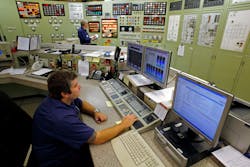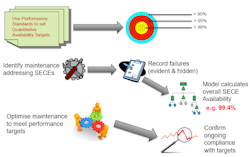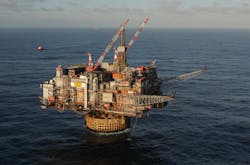Automated tracking tool verifies safety, reduces maintenance man-hours
Simon Lowe, Xodus Group Ltd. and Craig Reid, Canadian Natural Resources International
Safety critical maintenance and verification activities typically account for 25% to 40% of planned preventative maintenance man-hours offshore. These activities are essential for ensuring offshore safety but very often there is little measurement of their effectiveness.
Many operators’ performance standards now contain quantitative availability targets for some of their safety and environmentally critical element’s (SECE) safety functions. However, the verification of these targets is not always easy to demonstrate without specific one-off exercises to review maintenance records and perform offline calculations.
To improve and streamline the monitoring of SECE performance, Xodus Group assisted Canadian Natural Resources International (CNRI) to implement an automated process, which collected the necessary data from its web-based maintenance management system (MMS) on the Ninian Central platform in the northern North Sea.
System overview
Since July 2018, it is mandatory for all existing production installations to comply with an EU Offshore Safety Directive aimed at mitigating the risk of major offshore oil and gas incidents. This requires identification of major environmental incidents (MEIs) and the associated SECEs.
While the development of an integrated safety and environmental barrier system to prevent and control major accidents and their environmental impact is compulsory, evaluating and trending the achieved availability of key SECEs provides added insight and benefits. The first image shows a graphical overview of how the system is set up and operates.
It should be noted that CNRI had many of these systems and procedures already in place, allowing the project with Xodus to build on the existing framework to deliver the automated system. The integrated framework and tool were tailored to work with the operator’s existing MMS and in-house IT systems. Indeed, it was a key requirement of the development that all source data, including ongoing history, would be kept in the MMS.
Set target availabilities for SECEs
CNRI’s performance standards, like those of many operators, have quantitative reliability targets defined for the most critical SECEs where appropriate. Some of these targets are specified for a single SECE and others at system level. For example, systems such as fire and gas detection, emergency shutdown, blowdown, HVAC, etc. can have meaningful availability targets defined. Depending on how the targets have been set determines what data needs to be collected and what calculations need to be performed to determine the availability of any SECE or group of SECEs.
To track the availability performance, it is necessary to record all relevant failures on them. Like all operators, CNRI had in place procedures and mechanisms for firstly identifying safety critical maintenance being performed and secondly, recording when this maintenance identifies failures. The operator, which assumed ownership of the Ninian field in 2002, was able to identify failures that were being picked up by planned preventative maintenance routines as well as from corrective maintenance tasks. However, it was not possible to quickly collate the relevant types of hidden and evident failures on each SECE from the MMS without time-consuming manual intervention.
By configuring the necessary data into the MMS, it was possible to use standard reporting tools to automatically extract the relevant data. This allowed the raw data to be processed automatically to calculate both component and system level availabilities. It also allowed a direct link back to the specific work orders on which the failures had been identified. The user can literally click through from the tool to see these individual work orders in the MMS.
Effective and efficient maintenance regime
Over a prolonged period, it is possible for the SECE safety tool to assess if performance is meeting the targets set in the performance standards and ascertain the impact of rolling average trends. Both results can be equally useful. For example, in the case where failures have occurred and the current trend is below the target availability, effective measures have to be taken to address the root cause(s) of the failure(s). This will then be confirmed by the trend tracking upwards or vice versa.
By monitoring the performance of the SECEs it is also possible to optimize the maintenance regime itself. This can be done in several ways, including:
• Adjusting the frequency of the maintenance tasks in line with the availability being achieved
• Changing the content of the maintenance to address issues that are being highlighted.
While there are several clear benefits that have arisen from the implementation of this automated system, the greatest advantage is increased visibility of the SECE’s performance against the targets set in the performance standards. By making the actual performance of each SECE/performance standard instantly visible, any potential reliability issues are quickly identified and addressed, with the potential to reduce maintenance demands.
By extending the intervals between checks for hidden failures, this can result in reduced maintenance man-hours. On the Ninian Central platform, more than 2,200 man-hours per year have been saved to date with further savings already identified.
However, these changes are only being undertaken in carefully calibrated stages where the reliability history clearly justifies the change. The in-service functional safety assessment described in IEC 61511 Stage 4, includes discussion of measuring the in-service reliability of safety integrity level instrumentation and then adjusting maintenance intervals in line with the findings. The tool developed here can be used to support this process.
By setting up the system the identification of SECEs becomes much clearer. In addition, the relationship between the SECEs and the maintenance tasks addressing them is also improved by more extensive use of routes listing the individual tags addressed by each planned maintenance routine.
Ensuring a robust approach to safety
From setting the initial performance standard availability targets to how the results from maintenance are being processed automatically, a robust approach has been applied throughout the project with CNRI. In the case of setting the initial performance standard targets, these have been calibrated against the QRA model for the Ninian Central platform. As an inherent safety margin was built in, this exercise proved that the intended individual performance standard availability goals met with CNRI’s overall safety objectives.
For example, the gas detection availability calculation assumes a worst case of two-out-of-two (2oo2) point gas detection being required for executive action. The 2oo2 design reduces the probability of a false trip, as both channels have to fail in order for the system to be shutdown. However, this configuration has the disadvantage that the probability of failure on demand is twice higher than that of a single channel.
More than one detector on both channels will usually be exposed to a gas release giving a much higher level of redundancy and hence, system availability. Furthermore, in some modules, different detector types, such as line of sight as well as point detectors, may be present which would provide a minimum of 2oo3 detection redundancy. In all cases, only the most robust or worst (least reliable) configuration has been used for determining the availability to undergo trending.
This approach gives assurance that the displayed results can be relied on to track the asset’s safety performance. The implementation of this system, while not conceptually difficult, does involve a significant commitment to set up the necessary data structures within the MMS. It is also necessary to ensure the workforce is sufficiently trained to record the data in the correct manner.
A safer and more sustainable future
Efficiency in all areas of operations and maintenance is important for not only profitability but also continued economic and social viability in the current climate. Balancing the perceived competing drivers of maximizing safety while optimizing maintenance cost is an area that all operators are familiar with. Therefore, the importance of verifying that safety critical maintenance is delivering the required results in terms of system availability cannot be overstated.
The SECE performance tracking tool implemented by CNRI gives this assurance while also facilitating maintenance optimization based on measurable verified data. The same methodology and framework can be applied to any architecture and has already been successfully ported to the Microsoft Power BI and Teams environment.
The authors
Simon Lowe, Principal Consultant, Xodus Group Ltd. Simon is a Chartered Mechanical Engineer and TUV qualified Functional Safety Engineer with more than 30 years of experience in a variety of industries from heavy manufacturing through pharmaceutical, paper, nuclear and refining but primarily oil and gas where he has worked in the areas of reliability, maintenance and safety improvement. In recent years he has been involved in defining availability targets for Performance Standards as well as optimizing maintenance on numerous safety critical systems. This most recent work with CNRI has neatly combined these dual goals of verifying safety targets with optimizing maintenance.
Craig Reid, Instrument and Controls Team Leader, CNR International. Craig studied Electrical and Electronic Engineering at RGIT (now RGU), is a TUV qualified Functional Safety Engineer and has more than 30 years of experience in the oil and gas industry working in various areas including instrumentation, fire and gas and ESD systems, valves including construction and commissioning. Craig has been with CNRI since 2004, firstly as Instrument Technical Authority principally for Murchison and Ninian Central and for the last five years has been Instrument and Controls Team Leader with a focus on functional safety, maintenance performance and optimization.


